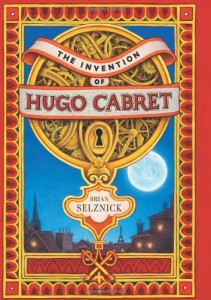 When I heard that Martin Scorsese was making a movie of one of my favorite books, The Invention of Hugo Cabret, I was delighted. Then when I heard they were changing the name to Hugo (which I’m still not happy about) and shooting it in 3D, I lost faith. I shouldn’t have worried.
When I heard that Martin Scorsese was making a movie of one of my favorite books, The Invention of Hugo Cabret, I was delighted. Then when I heard they were changing the name to Hugo (which I’m still not happy about) and shooting it in 3D, I lost faith. I shouldn’t have worried.
The story is about Hugo, an orphan boy who lives in secret rooms and passageways inside a Paris train station. His father is dead, and the only thing Hugo has to remember him by is the mechanical man his father had been repairing right before he died. From the pen in the automaton’s hand, it is clear that it was built to write something—but what? Using his father’s notebook, Hugo sets out to repair the automaton, coming to believe that it will someday write a final message from his father.
Unfortunately, in order to repair the mechanical man, Hugo must steal parts from a toy shop inside the train station, and he is soon caught by the shop’s owner, Papa Georges (as he is called by his young niece, Isabelle). Strangely, Papa Georges seems to know something about the history of the automaton, and, though he isn’t forthcoming, Isabelle gets drawn into the mystery, becoming Hugo’s ally.
I don’t post many reviews on this blog—in fact, I think this is my first movie review—but after seeing Hugo I felt I had to jot down a few thoughts. First of all, it’s really changed the way I see 3D. I’m a big follower of the grouchiest film reviewer in the business, Mark Kermode*, who believes that the rise of 3D is a corporate conspiracy invented to combat illegal downloading. (Really!) While I’m not sure I agree with him about that, like Mark, I’ve always found 3D gimmicky. I never thought it added much to the movie I was watching, and sometimes it distracted me so much that I was drawn out of the story.
 I started to change my mind about 3D during the very first minute of Hugo. The opening shot of Paris in the snow is absolutely magical. At one point, Hugo tells Isabelle that he believes the whole world is a machine, and Scorsese uses 3D to underscore this philosophy again and again—from the intricate workings of the automaton to the stylized view of the city of Paris moving like clockwork. Even the crowds of people in the station are beautifully choreographed cogs and wheels.
I started to change my mind about 3D during the very first minute of Hugo. The opening shot of Paris in the snow is absolutely magical. At one point, Hugo tells Isabelle that he believes the whole world is a machine, and Scorsese uses 3D to underscore this philosophy again and again—from the intricate workings of the automaton to the stylized view of the city of Paris moving like clockwork. Even the crowds of people in the station are beautifully choreographed cogs and wheels.
I don’t want to give any spoilers, but the history of film also becomes an important part of the story—and Scorsese’s magic is just as spellbinding here. There’s an amazing shot that takes place in an early film studio where actors are standing on a beautifully stylized underwater set with real fish swimming around them and real lobsters floating by. Only when we pull back do we see that the director is shooting the scene with a fish tank in front of the camera and that a stage hand is dropping live lobsters into the tank.
The mysteries that are eventually revealed about film history, Hugo’s father, Papa Georges, the automaton and the connections that link them all together are full of coincidences, but that just seemed to highlight the whole clockwork theme. I loved it.
Hugo is a magical journey. Bring tissues!
*Mark Kermode is famous for his “rants” against films he believes are hastening the end of civilization such as Transformers II and Pirates of the Caribbean. If you want a laugh, look up his review of Sex and the City II, which got him so upset he called all of the characters “capitalist pig-dogs” and started singing The Internationale. Check out his weekly BBC podcast with long suffering radio host, Simon Mayo.




 Hi! I'm Lena, a young adult fantasy author from Toronto.
Hi! I'm Lena, a young adult fantasy author from Toronto.
It is heartening to think of a great kid-lit book spawning a great movie. I personally wish movies were made from original screenplays. But if the movie sends a few to read the book, my curmudgeon-self will wave my usual reservations.
Very occasionally a movie can be even better than the book that inspired it. (I’d put The Wizard of Oz in that category.) I don’t think this is one of those times, but I think HUGO certainly does the book justice.